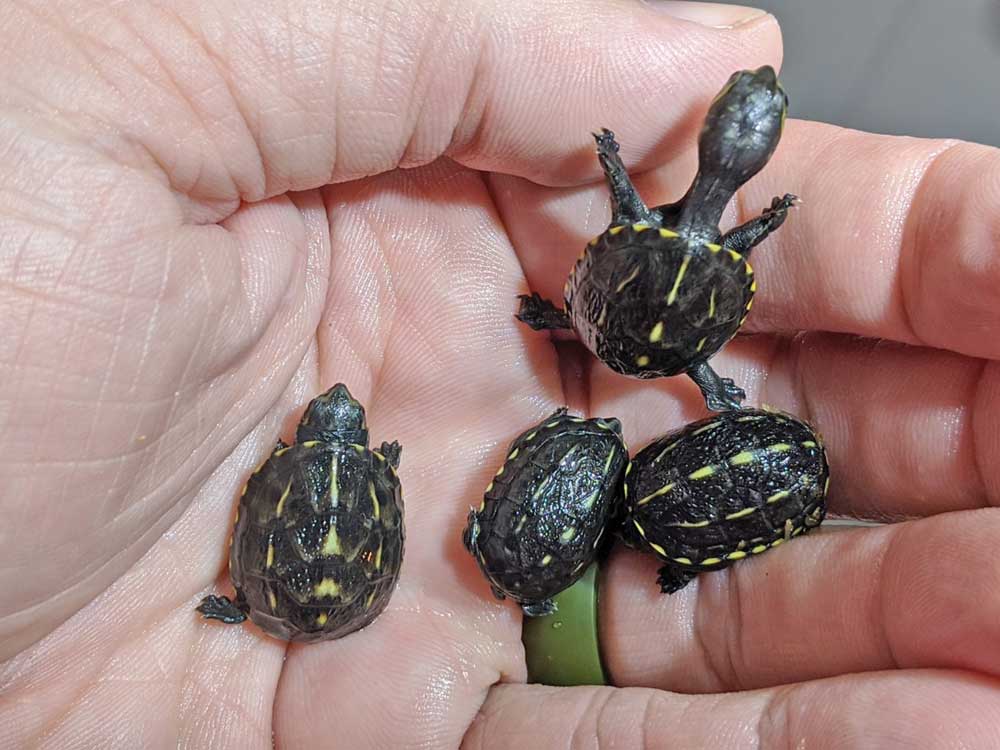The striped mud turtle is a small aquatic turtle that generally does not reach more than four inches (10cm) in straight carapace length (SCL).
There are many things to consider when researching the perfect turtle species for captive keeping. For example, adult size determines how difficult keeping the animal may prove to be years down the line. It can be argued that the adult size, along with lack of filtration, for more commonly kept taxa like sliders, lead to stigmas around turtle keeping as a whole. Challenges with water quality are not a fun thing to navigate.
Overall hardiness and adaptability to different captive environments can also be paramount when determining what candidate species may be best, especially for families and first-time keepers. A good experience with a pet can set the tone for a lifetime of appreciation for wildlife and exotic animals for a young person. It is with that in mind that this article on an underdog turtle species with a cult following is presented.
Striped Mud Turtle Description
The striped mud turtle is a small aquatic turtle that generally does not reach more than four inches (10cm) in straight carapace length (SCL). The species has a brown carapace (upper shell) that is oval in shape and has three stripes that may or may not be visible in all specimens. The plastron (lower shell) coloration can vary, from tan to a rust color, and there are two hinges that are customary for mud turtles in the genus Kinosternon. Striped mud turtles have large heads that usually have two small yellow stripes on each side.
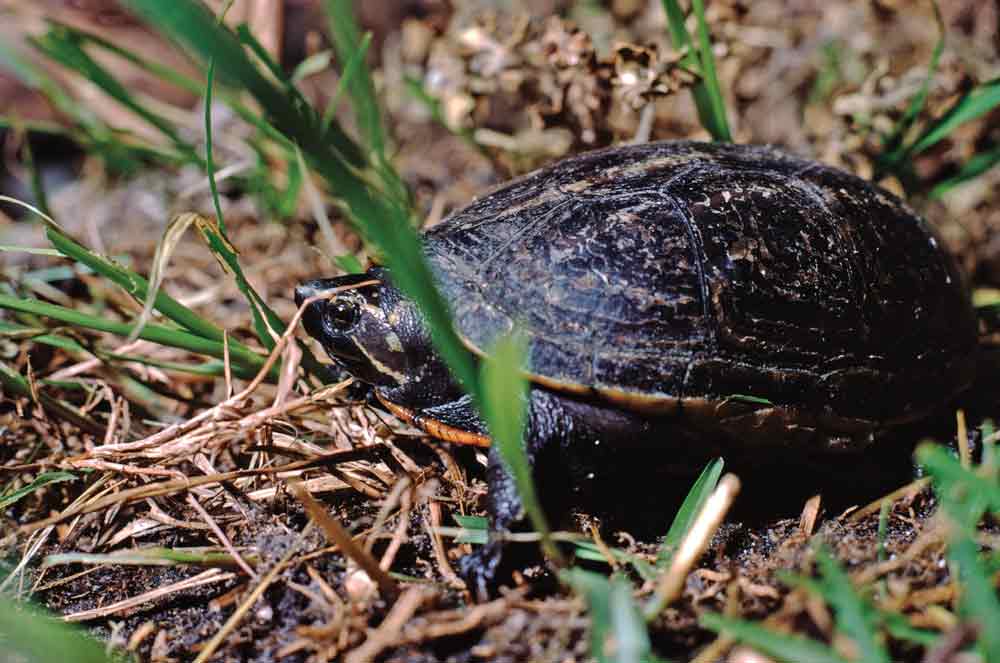
Striped mud turtles are a beautiful species that remain small in stature. Liz-Weber/Shutterstock
Striped Mud Turtle Range
The striped mud turtle, Kinsoternon baurii, naturally occurs in the southeast United States, extending southward from southern Virginia, through North Carolina, South Carolina, Georgia and all the way through Florida, down to the Keys.
Striped Mud Turtle Behavior
The diet of the striped mud turtle primarily consists of insects, worms, snails, algae, seeds, and the remains of invertebrates, given the slow, clumsy nature of this species. Turtles prefer to remain hidden, whether in the water or during estivation during drier or colder conditions, a behavior also observed in captivity.
In the wild, nesting occurs throughout the year, but activity peaks between September and November. Female striped mud turtle can travel 250 meters (820 feet) from wetlands to nest, and in Florida, they can lay up to six clutches of one to six eggs per clutch, per year. The average number of clutches is four. In localities with smaller adult animals, clutch size is generally only one to two eggs. In more northern localities, the breeding season is shorter, and fewer clutches are laid. Striped mud turtles generally inhabit ponds and ditches, both brackish and freshwater.
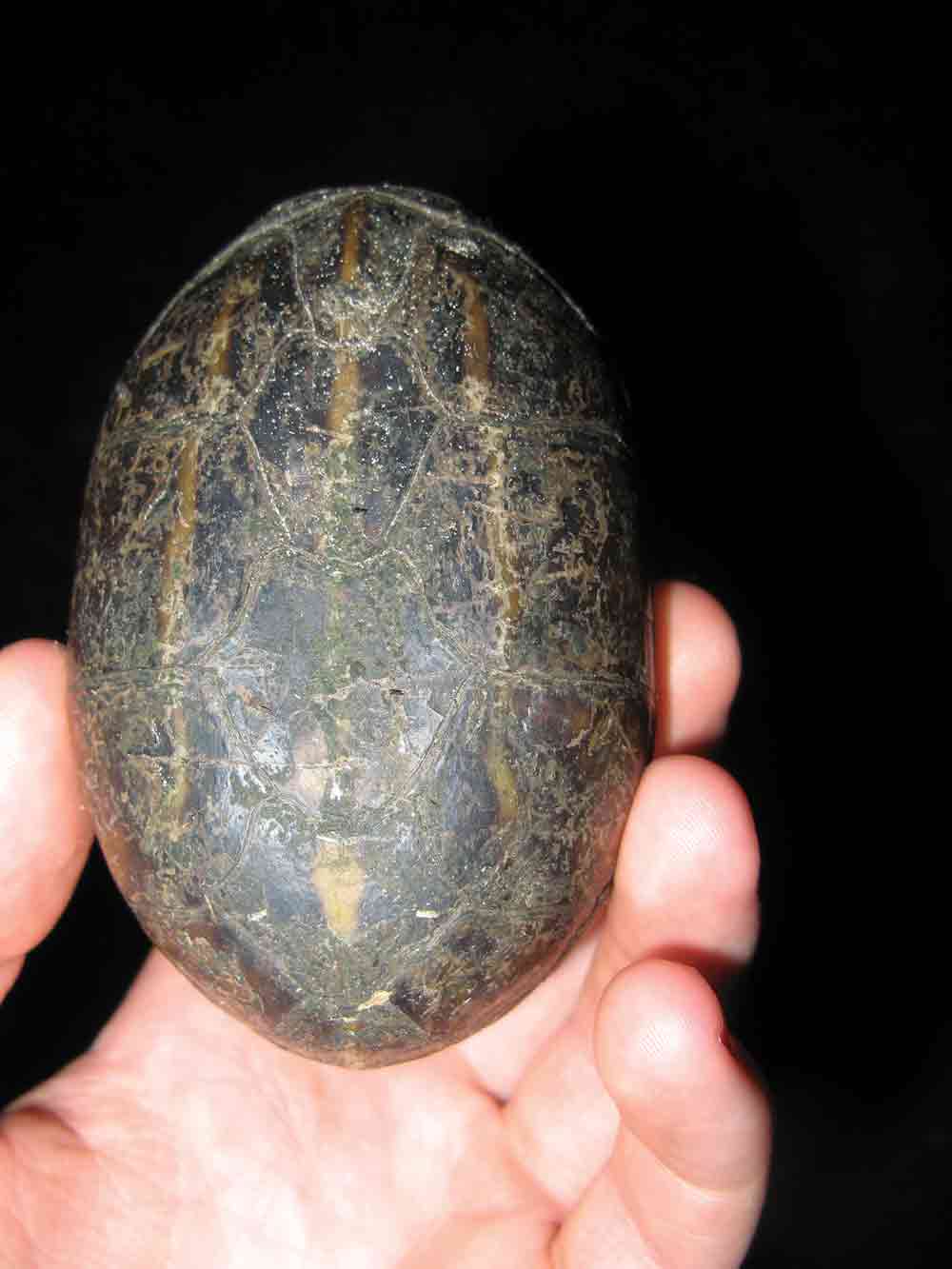
The stripes are faint on this turtle. Photo by Anthony Pierlioni
Geographic Variation In Striped Mud Turtles
Striped mud turtles differ greatly geographically. In the Apalachicola River tributaries in Florida, the species grows large, closer to five inches and lacks the three stripes for which the species is known. In the area in and around the Florida Everglades, the species is smaller, generally maxing out around three inches and often displaying a beautiful “blond” coloration generally associated with older females of other localities.
There is also a population found in the Florida Keys. This population was protected because it was proposed as a separate taxon, but subsequent research has concluded that this is not the case.
Threats To Striped Mud Turtles
Most turtles are at risk of decline thanks to a myriad of factors. It appears striped mud turtle are no exception. Increases in egg predation due to a growing amount of predators, road mortality, real estate development, collection for the pet trade and likely pollution all pose a risk to the species.
Because the species does not love overly salty water, the population in the Keys are considered to be at risk, due to limited available areas to live and the risk of rising sea levels and salt water overwash. This brings high salinity water into their habitats and subsequently makes those areas unliveable. Available habitats are quite small in the Keys, so options for these turtles are limited.
Striped Mud Turtle Captive Care
The first consideration when acquiring any animals should be that they are healthy and obtained from a reputable source. All new animals should be quarantined from animals in the existing collection, especially if adult animals are being brought in. For a group consisting of one male and two females, a Zoo Med Turtle Tub is a perfect size. This provides the land and water environment the species needs. For larger groups, larger tubs are recommended. The large footprint of these tubs is ideal for this species, as swimming is not a strength. Be sure to have a plan to separate animals if aggression takes place.

A fully grown striped mud turtle. Photo by Anthony Pierlioni
A sandy substrate works best as the turtles enjoy it for laying and digging and it does not dirty up the water too much. Play sand can be purchased from home improvement stores inexpensively. Filtration is easily provided by one of the smaller, readily available options one might find at a pet store, like the TetraFauna ReptoFilter. This is finally a species where commonly available pet supplies actually work well. Driftwood and fake plants in the water provide necessary cover to reduce stress, especially in aquariums or if kept in groups.
Lighting should be used on one side of the enclosure, to provide a bright, warm area and a darker, cool area. When in use with a combo tub with a land and water area, the light is placed near the ramp, where turtles can bask and where the dry substrate of the terrestrial area can be warmed during the day to encourage egg laying behavior. Supplemental heating of the water is not needed if the turtles are being kept indoors. In fact, we let our turtles fall into the 50s Fahrenheit in the winter and let them slow down in both feeding and behavior during that time. The enclosure warms up every day as the lights come on, but they are really only warm (80s Fahrenheit) for half the year.
Both a terrestrial and aquatic section of the enclosure is needed in this species, to be able to provide important aspects of their natural history and behavior. Basking is also important and both basking heat and UVB should be provided. While younger turtles do not generally bask, adult turtles do, specifically gravid females.
What To Feed Striped Mud Turtles
Being they are omnivorous, keepers of striped mud turtles can be creative in the foods they choose to provide for their animals. We recommend using a high quality pellet as the staple of the diet. Better still, consider using a blend of high quality pellets to ensure a varied and complete diet is offered to your turtle.
The diet can then be supplemented with other items as you see fit. Frozenthawed shrimp, guppies, cuttlebone, beefheart, and vegetables are all used to supplement the diet of our captive striped mud turtles. The turtles are generally voracious eaters, so care must be taken not to over feed them and cause obesity in your animals. Adults are generally fed three times a week, and hatchlings once per day.
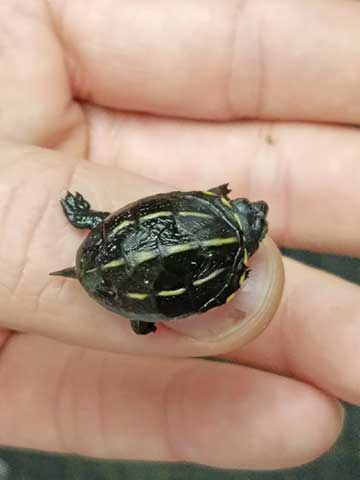
A hatchling sitting on the author’s thumbnail. Photo by Anthony Pierlioni
Striped Mud Turtle Breeding and Incubation
Striped mud turtles are relatively easy to breed. If you provide them with a proper enclosure and have healthy animals that are not overly stressed, they will produce offspring. Eggs buried and covered in substrate have a better chance of hatching, but eggs found in the water should also be incubated. Fertile eggs generally take on a white appearance as they develop. Sometimes, eggs will develop a white band across them early in development, a sign that they are fertile.
Incubation is rather straightforward, where warm temperatures are generally tolerated and no diapause or special substrate is necessary. We have incubated the eggs on both vermiculite and damp sphagnum moss, with success using both. The benefit to using vermiculite is that you can measure the substrate and the amount of moisture you are adding to it. We recommend a 1:1 ratio of vermiculite to water by weight. This way, you can weigh the container and add drops of water periodically with a pipette to ensure the saturation level remains within range.
Incubation takes a relatively long time, with eggs generally taking 70 to 120 days to hatch, but there are exceptions, of course, where eggs can take even longer. Incubation temperature determines the sex of the embryo – at more than 82 degrees Fahrenheit (27.8 degrees Celsius), the majority of the embryos are females. Males are produced at intermediate temperatures and an even mix is produced at much lower temperatures, which is a rarity. In the wild, it can take the young over a year to emerge from the nest cavity.
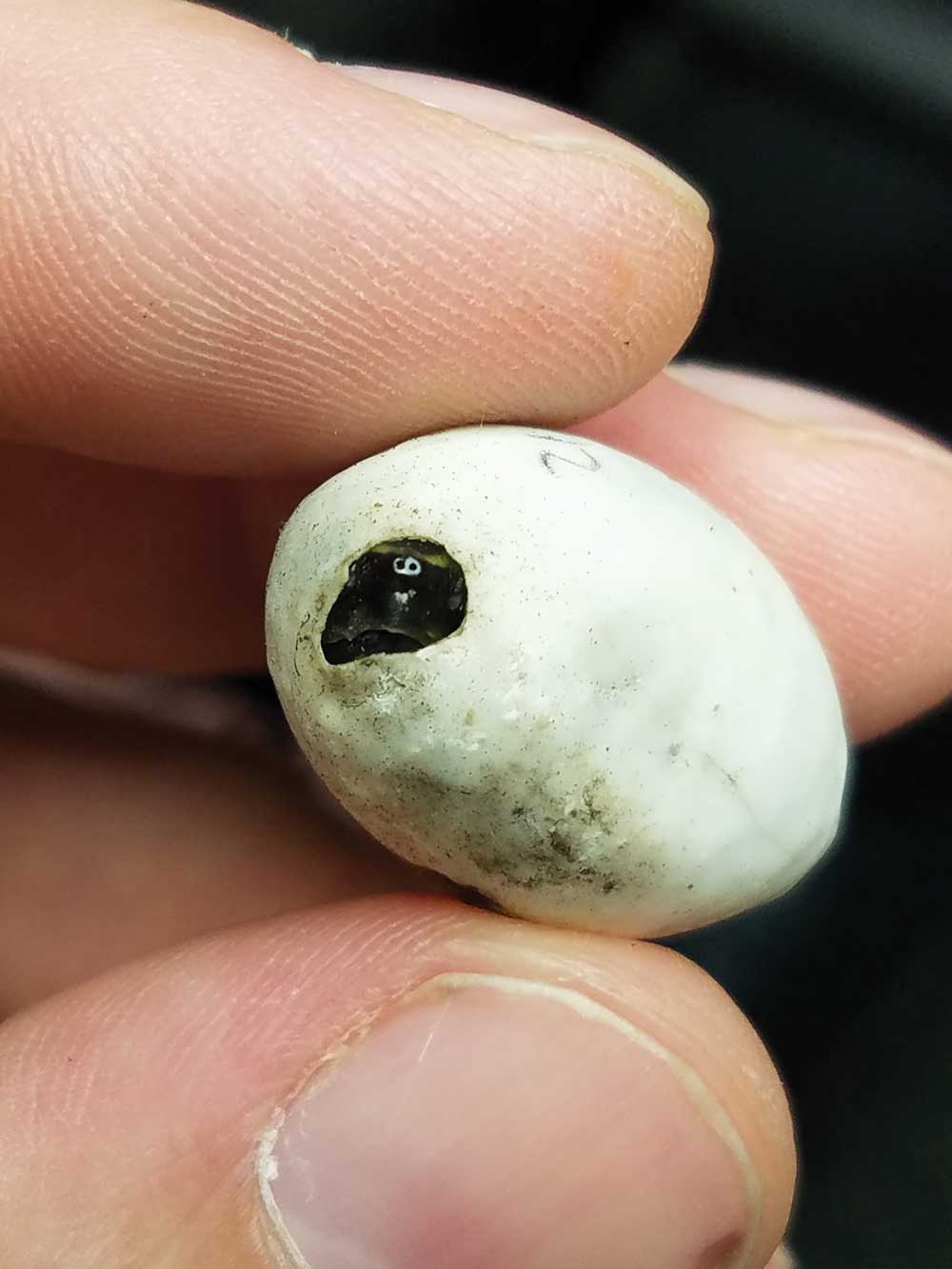
Striped mud turtle pipping. Photo by Anthony Pierlioni
Common Health Issues
In chelonians, and perhaps in all animals, to differing effects, stress kills. Striped mud turtles are no exception to this rule. In years of working with them, all health problems can be traced back to stressful situations. There are two main considerations to be made around this information. We must imagine the amount of space a mud turtle has to use in the wild and how often they are solitary, as well as the amount of cover the animals have in the wild.
Too often, new keepers will set up an enclosure for a Kinosternid that is lacking cover or stocked too densely with animals. While it is true that these animals are quite small and require less space than your traditionally kept turtle species, provisions must be made in these instances. Utilize densely arranged fake plants and driftwood to provide cover for animals and a sandy substrate on land and in the water area to allow for cover. Sand in the water portion of the enclosure will also allow turtles to avoid becoming stuck under driftwood and drowning.
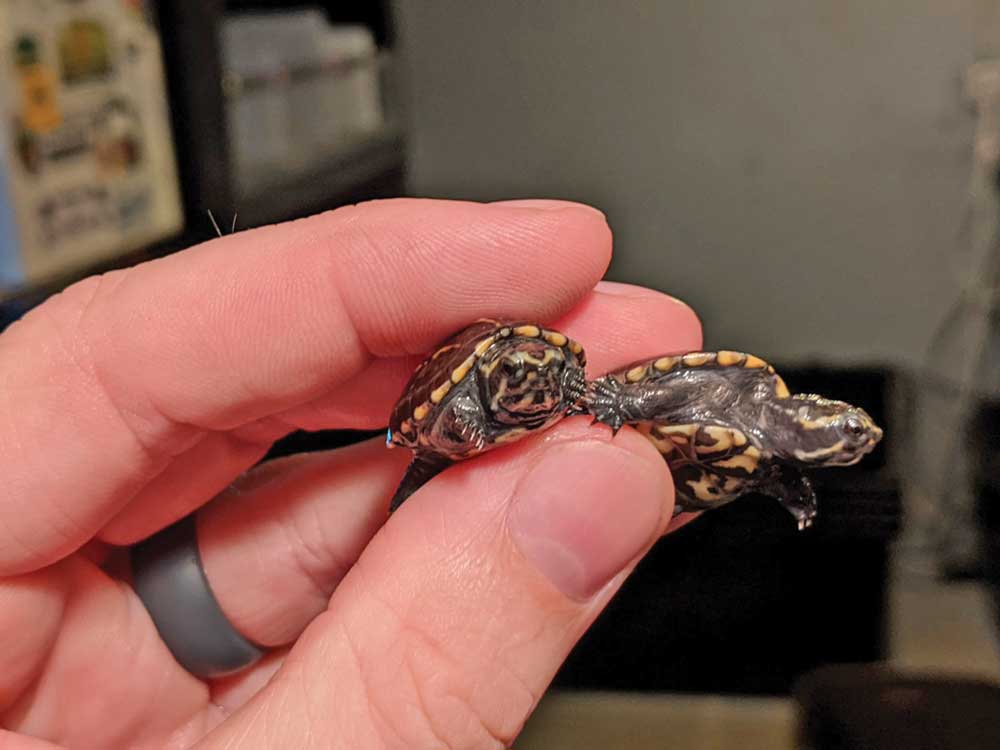
Two clutchmates produced by the author in 2019.
With striped mud turtles, the largest cause of stress is the aggressive nature of males. It is recommended to new keepers to have individual accommodations available for the males, when a new group arrives. This way, males can be added to the females for breeding, but are not left with the group at all times. Males will often bite the rear marginal scutes of females, causing significant damage and even removing posterior portions of the carapace. If your females seem to be falling in love with the terrestrial portion of their enclosure, this is likely the reason why. Female to female aggression can also take place, but most instances are male generated.
Hatchling Care
Hatchling striped mud turtles are incredibly small, sometimes a hair under two grams in weight. After emerging from their tiny, jelly-bean sized eggs, they are generally ready to roll. As with most hatchling turtles, first meals always come sooner if live, wiggly foods are offered.
Earthworms, snails, isopods, and other items can be used in this instance. For smooth growth, pellets are recommended as the staple diet, even for hatchlings. Surprisingly, pellets are accepted very early, even as a first meal after hatching. It can take several days or even weeks for a fresh hatchling to take its first bite. Hatchlings will even take full sized adult pellets. Their large heads, relative to their body size, gives them the ability to bite through larger pellets.
Hatchlings are kept in a small Tupperware or plastic shoebox container, no more than six quarts. Water is kept shallow, just enough to cover the top of the shell, with a generous amount of sphagnum moss for the turtle(s) to feel secure. The turtles can be fed directly in the container, so they can continue to hide and eat at the same time, the way they would prefer to even in the wild.
At this small size, these turtles would likely spend all of their time hiding. Bright light of the direct sun would likely stress them, so cover is likely more important than UVB, which is more important for the adults. The water and sphagnum moss within it are very easily cleaned by using a pasta strainer to rinse the moss. Filtration proves to be a very difficult undertaking when the charges you are caring for are smaller than a fingernail.
Striped Mud Turtles Are Great Pet Turtles
What is most commonly found for sale is not what is necessarily best for families looking for a fun and rewarding exotic pet. Thanks to the federal four-inch law, species like the red-eared slider (Trachemys scripta elegans), remains popular. Despite the outlawing of the sale of small turtles in pet shops, the high fecundity, or breeding output, of these turtles kept them popular. Add to that the fact that a slider can grow to four inches in a matter of months, and you set up a scenario where most turtle-loving American households are caring for turtles that are not best suited for them. This leads to higher amounts of work needed to care for the animal and unfavorable outcomes.
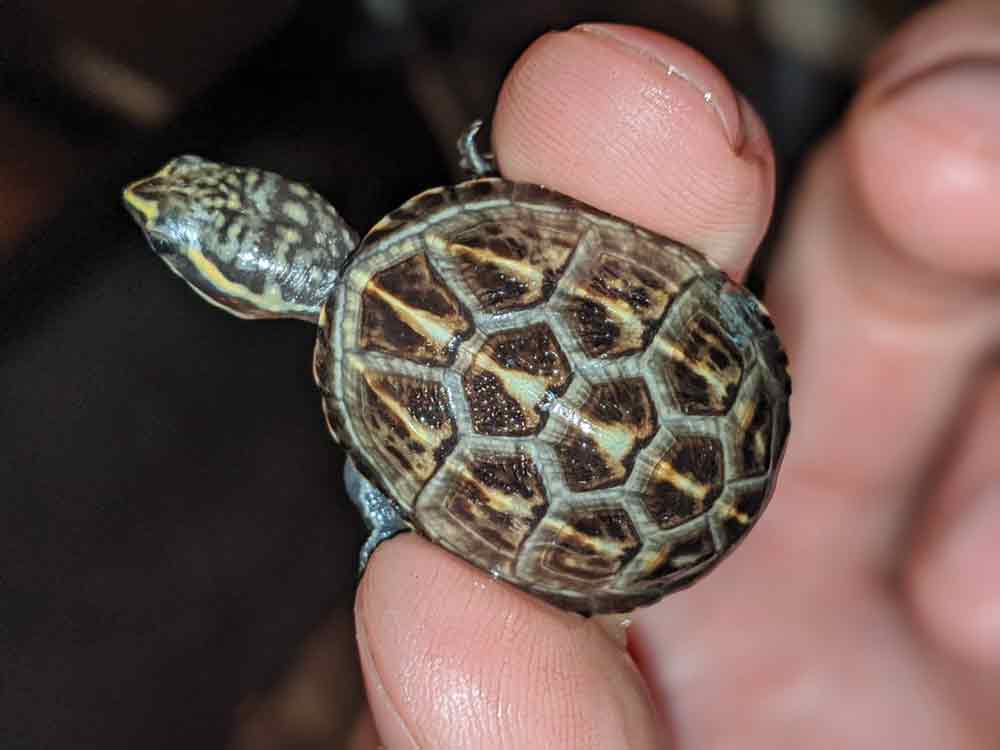
Check out the coloration on this young turtle. Photo by Anthony Pierlioni
Wouldn’t it be wonderful if there were turtles that were a smaller size, that adapted well to a variety of captive environments? It would be amazing to see such an animal and the impact it could have on families and young people. Luckily, species like this do exist, and they are available from online private breeders. The federal law restricting the sale of turtles under four inches does allow for purchase of smaller animals if used for scientific or educational purposes. This may be worth considering for a family project now that home-schooling and distance learning become more commonplace. Just remember these animals live fairly long lives.
Striped mud turtles are engaging, comical, and are voracious eaters that respond well to the husbandry provided them. In other words, if you take care of them, they respond. For those wishing to breed turtles in captivity, which can generally be more challenging than with many other herps, striped mud turtles are rather straightforward. If you keep in mind the potential risk of male generated aggression, the species is easy to work with and rewards keepers with a sporadic, year-round bounty of eggs, which keeps you on your toes, in a good way.
Buy Captive Bred Striped Mud Turtles
Striped mud turtles are a mainstay in the pet hobby. Although they pale in comparison to the ever popular sliders, they are steadily available via online sales. Keep in mind, when you see adults for sale, those animals are almost always wild-caught, often recently. Wild-caught animals are more difficult to acclimate, and they don’t always do well. What’s more, if you acquire wild-caught animals that you are paying for, it is possible you are taking part in the breaking of a law.
Captive-bred mud turtles are often available, perhaps none more so than the striped mud turtle. Hatchlings are incredibly small, but for what they lack in size, they make up for in attitude. Yes, they will try to bite. These captive bred animals also come free from parasites and have lived their entire lives in the comfort of a captive life where everything they need is provided and where they won’t be carried off by a bird or eaten by a frog or fish. Wild-caught animals are used to the wild and we should do everything we can to keep them there and conserve their habitat.
Anthony Pierlioni is the vice president of theTurtleRoom, an international turtle conservation organization. He keeps and breeds numerous endangered species of turtles and tortoises and works to educate the public about their plight. Anthony’s book on leaf turtles was published in 2016. He is also the host of the “Pondcast,” a show dedicated to reptiles and the people who love them, and “Turtley Devoted,” which looks at the relationship between reptile lovers and the people who keep them. Follow him on Instagram and FaceBook.

